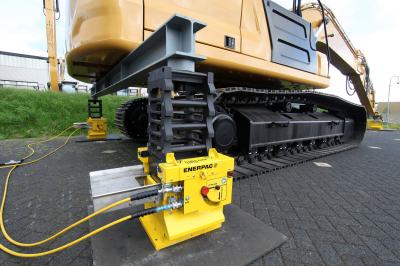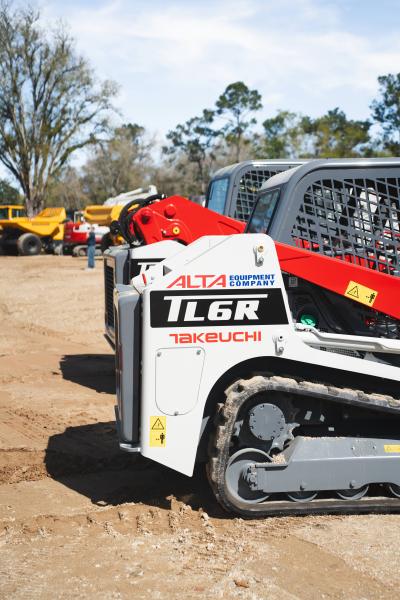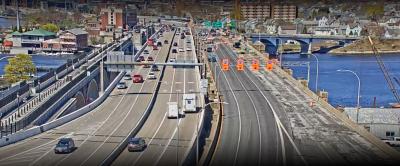The 1939 World Fair stirred visitors with a “World of Tomorrow,” including sleek cars moving smoothly along wide superhighways, through majestic skyscrapers. It came true, of course, in the second half of the century.
What is the “World of Tomorrow” for our highways and cars in the next 25 to 50 years?
Construction Equipment Guide (CEG) interviewed David Hartgen, professor of transportation studies at the University of North Carolina’s Charlotte (NC) campus about his vision for the future. (Hartgen is noted for his annual evaluations of state highway systems throughout the United States.)
Changes Ahead
“I do remember seeing the transportation technology of the future in those great childhood magazines that usually had us all flying around in one-seat helicopters,” Hartgen told CEG.
He added, “Things develop in surprising ways. If you had called me 10 years ago, I never would have used the word Internet or E-Trans or any of the things, which we take for granted now. I’m reluctant to step too far out on the plank but I’ll give it a try. I guess the good news is that I won’t be around in 50 years to see if I’m right.
“First, we can’t get around the physics. Gravity will still be the basic force we all deal with, plus friction of both rolling and air resistance. Gravity means we will have to stay on the surface of the earth. I don’t think that flying [car] technologies will come to pass, or that mag lev [magnetic levitation] will be practical. It takes energy to raise vehicles. The fundamental problem with mag lev is that it takes more energy to raise the vehicle than to drive it.”
Hartgen said that most of the world’s transportation technologies will be on different fuels in 50 years:
“We will see very substantial incremental movement over 50 years. We’ll probably have new fuels, mainly hydrogen-based, not just fuel cells but also other hydrogen-oxygen combinations, and perhaps nuclear-based and some lingering petroleum-based technologies.”
Highways of the Future
Hartgen also envisages a vastly improved highway system:
“The basic problems we currently have, that is, congestion at guideway [road] choke points, will be different. The basic problem will be the same but the locations will be different. We’ll probably have a higher interstate system. By that I mean another interstate network functionally above the one we now have. This will probably be a toll-driven pay-for-use system at very high speeds, perhaps even automated connectivity of the vehicles —either electronic chains or possibly mechanical chains, sort of like trains now. They could be uncoupled at the ends [of the highways] so vehicles, or freight, could use local road systems to reach their final destinations.
“We’re just now beginning to link vehicles electronically with systems called PATH and PATHFINDER so that individual vehicles can move together under electronic control. There would be very short spacing, perhaps one foot between the vehicles, which would move perhaps as fast as 200 miles per hour [mph]. We’re seeing this begin in terms of vehicle detection and ITS [Intelligent Transportation System] technology. Certainly within 50 years we’ll have most of that worked out. Only the high-level systems will be automated. Most of the rest, including local roads, will not be.”
Hartgen said he believes that actually linking vehicles mechanically in future truck-trains (trucks with multiple trailers) on future highways is less feasible:
“The problem with mechanical hooking is that you need a controlling guideway to keep the vehicles from moving apart. We won’t be able to afford most of that for most locations. However, there will be a lot more modularization, particularly of freight, with very smooth interfaces between the modes, and more containerization of freight components.
“The Transportation International Unit [TIU] standard for size of small containers will probably be 20 feet rather than 40 feet. There will be longer groups together but smaller individual compartments. The reason for that is that manufacturing will be very dispersed. Smaller manufacturing won’t require 40-foot trailers anymore. A much more site-directed delivery system will replace them.”
Will the new highway networks be markedly different than today’s? “I don’t know whether there will be too much change,” Hartgen replied. “We can now keep cars together on a 12-foot track, essentially a lane. I think 12-foot lanes will continue to be the standard for higher-speed vehicles, with much smoother interface between vehicles merging. Capacity problems will be much smoother. In order to make this work, we will need a separate geometry from the current interstate system. The speeds will be so high that the system will have to be very straight.”
What about the materials in highways of the future?
“We may have evolved a permanent material, which will be water-proof and decay-proof. If I were to guess, it would probably be some blend of asphalt and some type of plastic composite. You can throw a cigarette butt now and it will last one million years. If we do that by default, we can do it with highway materials. Certainly the materials are available now to do that. The problem is price. I would expect that the price of this technology will come down. So the idea of highway maintenance essentially disappears, at least at the higher levels. The local system is different. We couldn’t afford to put the material everywhere. We might even evolve a spray version of the material, a high-tech version of what you do in your driveway, something which you could purchase in your building supply store and spread out with a roller so that it would harden to an impermeable seal.”
Cars of the Future
The future cars on the new highways, Hartgen said, “will be much safer; if they crash, safety features will be designed internally so that you essentially have a NERF car, like the very soft NERF balls you used to hit as a kid. This would be sort of a backwards-NERF car, soft on the inside but hard on the outside.
Accident rates will be lower because of better controls, but injury rates and severity of accidents will be much, much lower. Accident rates will probably be one-half to one-third of what they are now, roughly one per 150-million vehicle miles. They are now at about one and one half per 100-million.”
The researcher said cars will be equipped to use new super toll roads for long distance travel, but comments: “Everything, of course, has a price. What you will have to pay for is the speed and the ease of control as you are guided by electronic systems.”
Even after the advent of the new intelligent superhighways, Hartgen said, cars will still be equipped with steering wheels.
And the world of tomorrow, he added, “will continue to be vehicle-oriented; the democratization of mobility will continue very rapidly; mobility is an incredibly valuable freedom which is not mentioned in our demands for rights.”
Future Cities
“Cities will be much larger, geographically,” Hartgen said. “There is no evidence that sprawl is likely to slow down. I don’t think we will deal with the sprawl issue any better than we dealt with the race issue in this country. No-one is willing to pay the price for doing what will be required to densify cities, or somehow live in ways that eliminate sprawl.
“I think airport connectivity will probably have less traffic. We’re already seeing this beginning to happen, with air travel beginning to decline as a percentage of the total, being replaced by high-speed ground technology. The hassle of getting in and out of airports will simply not be worth it under 200 miles.”
More Privatization
Hartgen foresees a lot more private ownership of transportation systems:
“More privatization, everywhere, things like toll roads, pay-for-use lanes, and services, a very different kind of organizational environment than we have now. Basically what we have now is a public environment. The public sector builds the system and the private sector uses it. I think in the future we’ll have the private sector both building and offering systems. The private sector might be asking for contractors to build and repair their systems. This would get a lot of the government chicken-poop out of the way so that all of a sudden you would have something akin to the banking industry.
“Mostly the banks do the contracting for services. We’re seeing privatization more and more, everything from the Dulles Toll Road to Interstate 91.”
Building Smart Roads
One of the leaders of the four-mile “Smart Road” test track near Blacksburg, VA, predicts that the first automated highway systems, with cars steered automatically, will be operational in 10 to 20 years.
Ray Pethtel, associate director of Virginia Tech’s Transportation Institute, which runs the Smart Road project, said the technologies are in place, or under development, to make this timeframe feasible.
“Both magnetic and vision-based technologies are being developed for automated steering, which is the basic technology we need to actually get vehicles that can handle themselves without a driver,” he told CEG, and added: “We already have adaptive cruise control so you can control your car in the line of traffic. We have collision-avoidance technology. About the only technology we would need for autonomous vehicles is automated steering. I think that will come as a driver-assist rather than replacement of drivers.
“Once automated steering comes, and the market penetration of that technology in vehicles is great enough, then I think you’ll find the owners of the infrastructure starting to adapt roads, or at least lanes, so that those kinds of vehicles can have unrestricted travel. There also are proposals for both automated and conventional traffic in the same roadway; that’s probably a little further off.”
Operational systems will need communications between vehicles, and between the roadway and the vehicles, Pethtel said, “and I think the new capability in broadband wireless technology is the platform that will be used more and more for this.”
“While the drivers may not know what’s going on, the vehicles will,” Pethtel added. “Then the question will be one of simple economics and efficiency, whether the roadways themselves are going to be instrumented, or the vehicles will be instrumented for those roadways. When we get out 30, 40 or 50 years, we’ll probably see a mix of both of those. There’s some debate whether the urban or the rural areas would be first [to be automated]. I tend to favor the long distance. There are, of course, some automated bus lanes and I think the first thing we’ll see is that type of thing.”
Why Not Now?
Pethtel said it’s “probably too soon” for owners of highways to equip them now for automated driving, “but that is coming.” He pointed out that there’s still a lot of debate about “platooning” (joining) vehicles and separating lanes for high-speed vehicles.
One of the limiting factors, he added, is that it will take years to penetrate the market and make every vehicle carry the same kind of technology: “The fleet turns over about every 11 years so it will take at least that long to have standard technology in vehicles that everybody could access. So, if you’re looking for safety, which is the number one concern, you probably need some kind of technology in the roadway [sooner].”
Pethtel expects “some type of cooperative relationship between the infrastructure and the vehicle” with support around, over, and perhaps in the roadway from things like acoustic sensors, radar, cameras, magnetic nails, transponder interrogators, and license plate recognition — all connected to computers.
All things considered, that adds up to more than a decade of continued development before automated systems arrive more completely.
“I’d say we’re still between 10 and 20 years for major [automated] systems to be up for demonstration, if not for use, with automated vehicles tying in with some kind of communication or other instrumentation in the roadway,” Pethtel observed.
The Test Track
An important test bed for future interstate highways, Virginia’s Smart Road is two miles long and two lanes in each direction, thus providing a four-lane test track. It includes approximately 500 sensors in the road, a four-mile fiberoptic self-fueling network, seamless wireless communication, a mile of lighting, which can be adjusted for height, distance apart and different kinds of luminaries, and a half-mile of all-weather capability to make fog, mist, rain or snow. It also includes a signalized intersection for crash-avoidance research, both for vehicles and infrastructure, and a wetbed for testing pavement markings.
“We’ve been doing research and testing for two and one half years, have about $40 million worth of research under way, and are doing a variety of in-vehicle, infrastructure, and public and proprietary research,” Pethtel said.
Virginia Tech’s Transportation Institute developed the Smart Road for the Virginia Department of Transportation. The test track also has been used in proprietary research for one of nation’s major auto firms.
Besides being associate director of the Transportation Institute, Pethtel is a University Transportation Fellow at Virginia Tech.
A demonstration section of roadway for automatic highways also was installed in San Diego, CA, in 1997. This road has the capability for self-steering. Vehicles would read magnetic nails in the roadway.
Today's top stories














